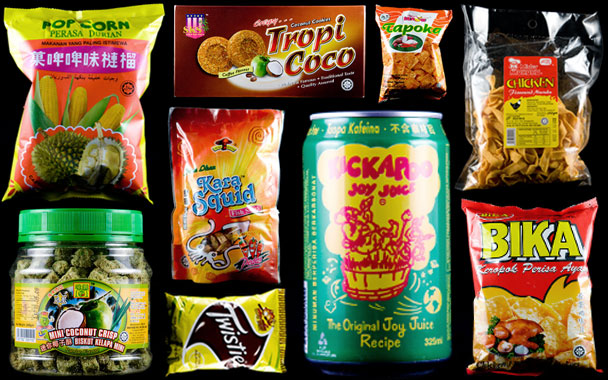It all started when I wandered into O.K. Hong Asian Food, in the heart of one of the two Chinatowns in New York City’s borough of Queens. There it was, in the center of the store: a mother lode of Malaysian junk food. Sweet, fishy, spicy, crunchy, and just downright weird, these packaged novelties included Pop Corn Perasa Durian; Twisties; chicken biscuits and chicken-flavored chips; and several types of muruku (fried chickpea-flour batter flavored with Indian spices), including one whose package looks like it hasn’t changed since the 1950s. There were also soft drinks, including Kickapoo Joy Juice (inspired by the beverage of the same name in the vintage comic strip Li’l Abner), to wash down all those sugar- and palm oil-laden snacks.
I was familiar with classic Malaysian dishes like beef rendang and Hainanese chicken rice; but until that moment in O.K. Hong, the only packaged Malaysian snack I’d ever seen, much less tasted, was durian cake. (For the record, the dark-brown, gelatinous sweet has a much tamer flavor than actual durian, thanks to the addition of plenty of coconut water and coconut milk.) Face to face with that mountain of Malaysian junk food, I decided to undertake what I humbly think of as a comprehensive survey of the genre. I called my buddy Zak Pelaccio, the chef behind New York City’s Malaysian-inspired restaurant Fatty Crab, to see if he could provide any perspective.
“I didn’t get to that point in my stay in Malaysia,” he admitted. “There’s so much food on the street—fresh durian, mangosteens, roti canai—I would never go the store and buy the equivalent of a bag of potato chips.” When further questioning revealed that Pelaccio had never even heard of a chicken biscuit, I knew that it would be nothing less than pure selfishness not to involve him in my study.
So I spent two days sampling my way through as many of these snacks as I could stomach, and then I was joined for a tasting by Pelaccio and his friends Will Goldfarb and Josh DeChellis. What follows are some of the highlights—and low-lights—of the project.
The Good:
Kickapoo Joy Juice
This citrus-flavored soda comes in a can decorated with a vintage Li’l Abner drawing, which no doubt adds to the soda’s nostalgic appeal. O.K. Hong’s proprietor, Melvin Eu, said that Joy Juice outsells Mountain Dew in Malaysia, which I find hard to believe, since the can clearly states tanpa kafeina, or caffeine-free. I’ll give him this, though: It tastes a lot better than Mountain Dew.
Miaow Miaow Tapoka
This snack’s package—with its smiling yellow kitty-cats replacing the letter “O” in “Miaow”—also bears a photo of several long red chilies, which should have tipped me off. The sweet, fishy, crunchy, and pleasantly piquant little squares caused the tip of my tongue to start burning after a few bites, but still I found it hard to put down the bag without finishing it. The chefs all loved it, too. I like to think of this as a spicy Malaysian fish stew transformed into chips.
Twisties BBQ Curry Best
Strangely, the Twisties bag proclaims that its contents are “for sale in Malaysia only.” Even though the ingredients are listed in Malay, it doesn’t take a native speaker to figure out what “monosodium glutamat” is (and that gave me pause, since MSG was also the sixth ingredient in Miaow Miaow Tapoka). I did have to consult Dr. Banhot’s Malay-Engish Cyber-Dictionary to learn that bawang merah and bawang putih mean shallot and garlic, respectively. Both are unusual ingredients for junk food, which explains why this crunchy snack looks like light-brown Cheetos but tastes like beef curry—a combination that we all thought worked extremely well.
The Bad:
Pop Corn Perasa Durian
I had high hopes for this one, thinking it might actually be something along the lines of durian-flavored Smartfood. Boy, was I wrong. Once I overcame the olfactory assault of opening the bag, I poured out a little. This supposed treat is actually durian-flavored corn puffs that look rather like biodegradable packing peanuts. Thankfully the flavor was much milder than the aroma, and there wasn’t too much aftertaste; still, my tasters and I were all pretty freaked out.
Muruku Ikan Popo
Eu recalled growing up in Malaysia eating these fried-chickpea chips, some of the store’s best sellers. I can only assume that their popularity is due to homesickness and/or nostalgia among Malaysian immigrants, since the crunchy chips have a greasy mouthfeel and none of the spice or fish flavor that they’re supposed to have. The chefs were all lukewarm at best on this one.



 Pinterest
Pinterest


